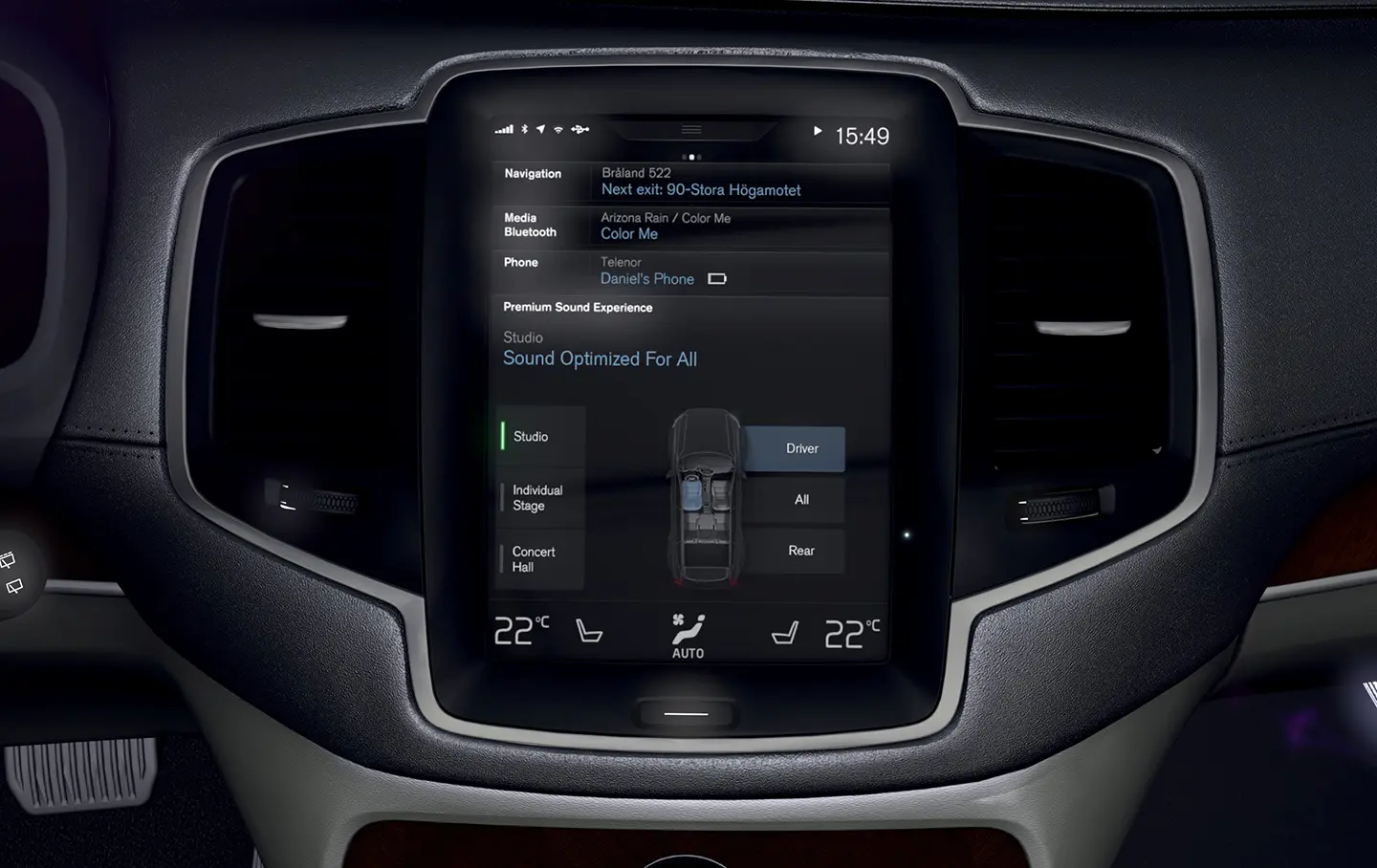For more than a decade, Volvo has been partnering with the audio specialists at Bowers & Wilkins, the British loudspeaker manufacturer originally founded as an electronics retailer. Having worked in clandestine radio operations related to the codebreaking work of Bletchley Park during the Second World War, John Bowers and Roy Wilkins understood a thing or two about radio transmissions and audio fidelity, and the company they founded continues that legacy. In 1980, Bowers & Wilkins loudspeakers became part of the audio setup in EMI’s Abbey Road studio.
The Beatles’ 1969 album release may have made Abbey Road a household name, but Abbey Road Studios remains a significant force in modern British music—artists from Massive Attack to Sam Smith, Little Simz to current contemporary jazz sensation Ezra Collective, have all recorded there. No surprise then that when Volvo and Polestar came to name the new Producer mode created by Bowers & Wilkins for the car company’s high-end audio offering, they referenced the iconic recording studio.
Abbey Road Studios Mode, set to debut in the new all-electric EX90, puts the virtual mixer in your hands. Presets range from vintage to a deeper modern feel, and the Producer mode allows full creative control. It’s the latest development in how high-end audio is part of the luxury automobile experience.
Go back 100 years, and the only onboard audio someone buying a Rolls-Royce would have experienced is the chitty-chitty-bang-bang of an unstressed inline-six motor.
Today, premium audio is as much a part of the marketable character of a luxury vehicle as is the depth of paintwork, the quality of leather, and the power under the hood. And in the age of electrification, audio quality is more upfront than ever: without the noise, the vibration, and the harshness of the harnessed explosions of a combustion engine, an EV comes out of the box with less interference for an audio engineer to hide behind.


Volvo’s high-end audio partner is Bowers & Wilkins, while Mercedes-Benz collaborates with Burmester.
Go back 100 years, and the only onboard audio someone buying a Rolls-Royce would have experienced is the chitty-chitty-bang-bang of an unstressed inline-six motor—unless they happened to drive past a marching band, they or their passenger had to sing the tunes themselves. (Today, Rolls-Royce offers an 18-speaker, 1,400-watt stereo from Bespoke Audio.)
The first in-car listening arrived at the beginning of the 20th century, mostly by amateurs taking apart the family transistor radio set and cramming it into their vehicle. Of course, this approach did not work well—if at all—with electrical interference making the radios impossible to operate when the engine was running. That changed in 1930, when one of the founders of Motorola showed up at the Radio Manufacturers Association trade show in Atlantic City with a Studebaker and a functioning, interference-free radio. It was the beginning of the Great Depression, and the cost for adding a Motorola to your car was astronomical. A Ford Model A, sales of which hit more than a million in 1930, cost around $600. A Motorola radio would set you back $110 and took several days to install. Nevertheless, people were willing to pay.
The first audio system to offer a significant upgrade over the Motorola, the Becker Mexico, was an optional extra in a Mercedes-Benz starting in the early 1950s. The Mexico offered AM and FM frequencies, along with a push-button automatic station finder. Later, at the tail end of the 1960s, Becker would offer the first two-channel stereo system, and Mercedes and Becker would also go on to lead the way in bringing compact disc technology into cars.
But before tape and CD formats made their debut, the record player was the only option for motorists who wanted to create their own in-car playlist. Chrysler tried to make a go of these on this side of the Atlantic, and aftermarket companies such as Philips offered units that could be installed in dashboards. George Harrison even had one in his Jaguar E-Type. But the inevitable needle skips made for a frustrating experience. Car record players remained a niche luxury product, and once the cassette tape came along, it blasted them (and the relatively short-lived eight-track) into irrelevance. The cassette tape’s durability and more robust playback system made it an audio experience suitable for listening on the go.
The first high-end factory-installed audio system was debuted by Cadillac in the 1983 Seville. A professor of electrical and sound engineering at Massachusetts Institute of Technology, Amar Bose, founded the successful home audio equipment company that bore his name in 1964. Approached by General Motors to partner on a system, Bose was able to hone his sound design: no longer at the mercy of how his products were set up in homes of differing shapes, sizes, and furnishings (all of which affect how sound fills a space), he now had the finite dimensions of the Cadillac’s cabin to operate within.


Bose engineers did so by using a human-shaped dummy they dubbed Morgan, one fitted with microphones where its ears would be and previously used to develop high-fidelity loudspeakers. With speaker angles carefully worked out to provide a proper stereo experience for each passenger, the Bose system took automotive audio to a whole new level, setting a new standard. With a strong consumer crossover between car and sound afficionados, other manufacturers were quick to work on their own offerings.
No luxury manufacturer is without an audio specialist partner these days. Land Rover uses Meridian to create three-dimensional soundscapes. Mercedes-Benz has a longtime collaboration with Burmester Audiosysteme GmbH. Bang & Olufsen, the Danish audio pioneer currently celebrating its 100th anniversary, provides premium audio systems to Audi, Bentley, Lamborghini, and Genesis. BMW, like Volvo, offers Bowers & Wilkins as its most premium option, and Infiniti recently partnered with the renowned home audio specialist Klipsch for the new Infiniti QX80.
When Lexus looked to build its flagship supercar, the V10-powered LFA, it was not enough that the engine produced acceleration that could pin your ears back. The company also turned to longtime partner Yamaha, specifically its musical instrument division. In a collaboration between automotive engineers and audio experts, the LFA’s system was designed to bring the resonance of its 10-cylinder howl into the cabin itself, giving drivers and passengers a fully immersive horsepower-howl experience.
In an electrified world, such a score needs to be built from the ground up. Hyundai and Dodge have created sound systems that mimic the rev and thunder of a combustion engine, but BMW went in a completely different direction, hiring the Oscar-winning composer Hans Zimmer to craft an engaging soundtrack for its performance-oriented M cars. With it, firing a BMW i5 M60 down an on-ramp feels like engaging hyperdrive in a starship.
But while some gearheads might find serious engine noise comforting, most automotive audiophiles are looking for more traditional relaxing warmth to accompany their commute. Building on the ideals first used by Bose, today’s high-end audio systems generally build out an interior sound field that takes into consideration the materials used in the cabin: glass that reflects audio waves, carpets and leather that will absorb them.
Software is key to creating these soundscapes, harnessing multitudes of speakers mounted throughout the vehicle. But the end result remains guided by a more fundamental principle—the human ear. Trained listeners are employed by audio manufacturers to gauge the success of a well-set-up audio system. Because what draws us in isn’t the power or the clarity of the recording—rather, it’s the humanity at the heart of it. It’s the way we feel what we hear.
Read more from our Autumn 2025 issue









